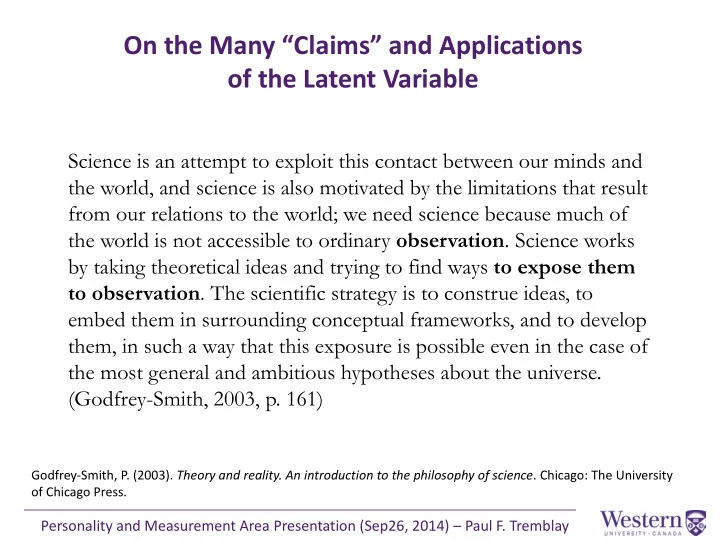

On the Many “Claims” and Applications of the Latent Variable Science is an attempt to exploit this contact between our minds and the world, and science is also motivated by the limitations that result from our relations to the world; we need science because much of the world is not accessible to ordinary observation . Science works by taking theoretical ideas and trying to find ways to expose them to observation . The scientific strategy is to construe ideas, to embed them in surrounding conceptual frameworks, and to develop them, in such a way that this exposure is possible even in the case of the most general and ambitious hypotheses about the universe. (Godfrey-Smith, 2003, p. 161) Godfrey-Smith, P. (2003). Theory and reality. An introduction to the philosophy of science . Chicago: The University of Chicago Press. Personality and Measurement Area Presentation (Sep26, 2014) – Paul F. Tremblay
Thinking about the Latent Variable from Three Perspectives • Mathematical model (e.g., SEM, MLM, IRT) • Theoretical model • Classical test theory (i.e., true-score, reliability) • Psychological concepts (e.g., g-intelligence, traits) • Construct validity – nomological (stochastological*) networks • Philosophical connections • Levels/units of analysis • Particles, molecules, cells, organ tissues, brain/nervous system, cognition, personality, social interaction, and culture. • Empiricism/positivism, operationalism, naturalism, realism Personality and Measurement Area Presentation (Sep26, 2014) – Paul F. Tremblay
Kinds of Mathematical Latent Variables 1. Principal component (not a latent variable) 2. Common factor model 3. Reflective measurement 4. Formative measurement 5. Various SEM (higher-order, bi-factor, MTMM) 6. Latent-class and latent profile analysis 7. IRT 8. Latent variables in longitudinal data (e.g., change) 9. Latent variables in MLM (random and contextual variables) 10. Network analysis of personality (Borsboom et al.)
Common Factor Model ( ) ∑ 2 λ φ ˆ ˆ i ρ = ˆ ( ) ∑ ∑ X X 2 i i λ φ + θ ˆ ˆ ˆ i ii In Kline (Raykov, 1997, 2004) Reliability of Effort = .896 Note arrows going from latent variables to indicators: Reflective measurement with effect indicators
Formative Measurement Note arrows going from indicators to latent variable Residual (1 – R 2 ) These indicators are referred to as “causal indicators” Bollen, K. A., & Lennox, R. (1991). Conventional wisdom on measurement: A structural equation perspective. Psychological Bulletin, 110, 305–314.
Other Examples of LVs with Causal Indicators 1. Social Interaction Time spent with family, with friends, with coworkers • 2. Quality of Life Health, happiness, economic status • 3. SES Education, income, occupational prestige • 4. Exposure to discrimination Race, sex, age, disabilities • 5. Stress Job loss, divorce, death in family, injury •
Deciding to Use Formative Measurement Causal indicators not necessarily correlated with other • indicators (implications for CTT and Cronbach’s alpha) Effect/reflective indicator can be deleted without changing • meaning of LV, removing a causal indicator can change meaning Imagine a shift in the latent variable: does it lead to a shift • in all indicators? (if yes, then effect/reflective indicators) Alternatively, a shift if one causal indicator would lead to a • shift in the latent variable Vanishing Tetrad test (Bollen) •
Formative Measurement χ 2 (2) = 6.638, p < .05, RMSEA = .083, CFI = .960
Formative Measurement
MLM of Diary Data – SEM Approach Notice the variation in the intercepts and the slopes
MLM of Diary Data – SEM Approach Weekly σ 2 17.720 t Drink Slope Depress WITHIN BETWEEN τ γ 32.614 00 5.386 00 intercept τ .189 γ 10 Trait -.054 n.s. 01 drinking τ Slope 0.007** 11 γ 10 0.022*
Latent Growth Modeling M = 5.238 M = -0.119
LGM vs. MLM of Longitudinal Data LGM MLM
Principal Components Analysis Kline, R. B. (2013). Exploratory and confirmatory factor analysis. In Y. Petscher & C. Schatsschneider (Eds.), Applied quantitative analysis in the social sciences (pp. 171-207). New York: Routledge. (Chap. 6, print proof)
Recommend
More recommend